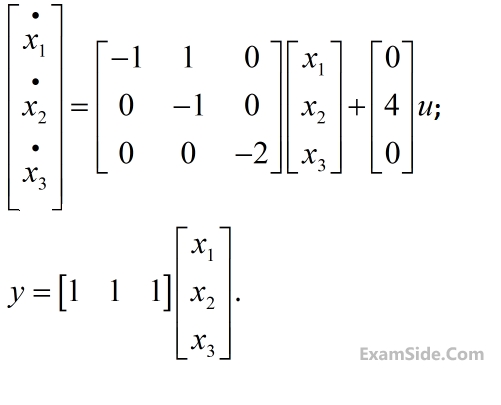1
GATE ECE 2016 Set 3
MCQ (Single Correct Answer)
+2
-0.6
A second-order linear time-invariant system is described by the following state equations
$$$\eqalign{& {d \over {dt}}{x_1}\left( t \right) + 2{x_1}\left( t \right) = 3u\left( t \right) \cr
& {d \over {dt}}{x_2}\left( t \right) + {x_2}\left( t \right) = u\left( t \right) \cr} $$$
Where x1(t), then the system is
2
GATE ECE 2015 Set 2
MCQ (Single Correct Answer)
+2
-0.6
The state variable representation of a system is given as
$$$\eqalign{
& \mathop x\limits^ \bullet = \left[ {\matrix{
0 & 1 \cr
0 & { - 1} \cr
} } \right]x;x\left( 0 \right) = \left[ {\matrix{
1 \cr
0 \cr
} } \right] \cr
& y = \left[ {\matrix{
0 & 1 \cr
} } \right]x \cr} $$$
The response y(t) is
3
GATE ECE 2015 Set 3
MCQ (Single Correct Answer)
+2
-0.6
A network is described by the state model as
$$$\eqalign{
& {\mathop x\limits^ \bullet _1} = 2{x_1} - {x_2} + 3u, \cr
& \mathop {{x_2}}\limits^ \bullet = - 4{x_2} - u, \cr
& y = 3{x_1} - 2{x_2} \cr} $$$
the transfer function H(s)$$\left[ { = {{Y\left( s \right)} \over {U\left( s \right)}}} \right]is$$
4
GATE ECE 2014 Set 1
MCQ (Single Correct Answer)
+2
-0.6
Consider the state space model of a system, as given below


The system is
Questions Asked from State Space Analysis (Marks 2)
Number in Brackets after Paper Indicates No. of Questions
GATE ECE 2025 (1)
GATE ECE 2024 (1)
GATE ECE 2018 (1)
GATE ECE 2017 Set 2 (1)
GATE ECE 2016 Set 3 (1)
GATE ECE 2015 Set 2 (1)
GATE ECE 2015 Set 3 (1)
GATE ECE 2014 Set 1 (1)
GATE ECE 2014 Set 4 (1)
GATE ECE 2014 Set 3 (1)
GATE ECE 2014 Set 2 (2)
GATE ECE 2013 (2)
GATE ECE 2012 (1)
GATE ECE 2011 (1)
GATE ECE 2010 (2)
GATE ECE 2008 (1)
GATE ECE 2007 (3)
GATE ECE 2006 (1)
GATE ECE 2004 (3)
GATE ECE 2003 (1)
GATE ECE 1999 (1)
GATE ECE 1997 (1)
GATE ECE 1992 (1)
GATE ECE 1991 (1)
GATE ECE Subjects
Signals and Systems
Representation of Continuous Time Signal Fourier Series Fourier Transform Continuous Time Signal Laplace Transform Discrete Time Signal Fourier Series Fourier Transform Discrete Fourier Transform and Fast Fourier Transform Discrete Time Signal Z Transform Continuous Time Linear Invariant System Discrete Time Linear Time Invariant Systems Transmission of Signal Through Continuous Time LTI Systems Sampling Transmission of Signal Through Discrete Time Lti Systems Miscellaneous
Network Theory
Control Systems
Digital Circuits
General Aptitude
Electronic Devices and VLSI
Analog Circuits
Engineering Mathematics
Microprocessors
Communications
Electromagnetics